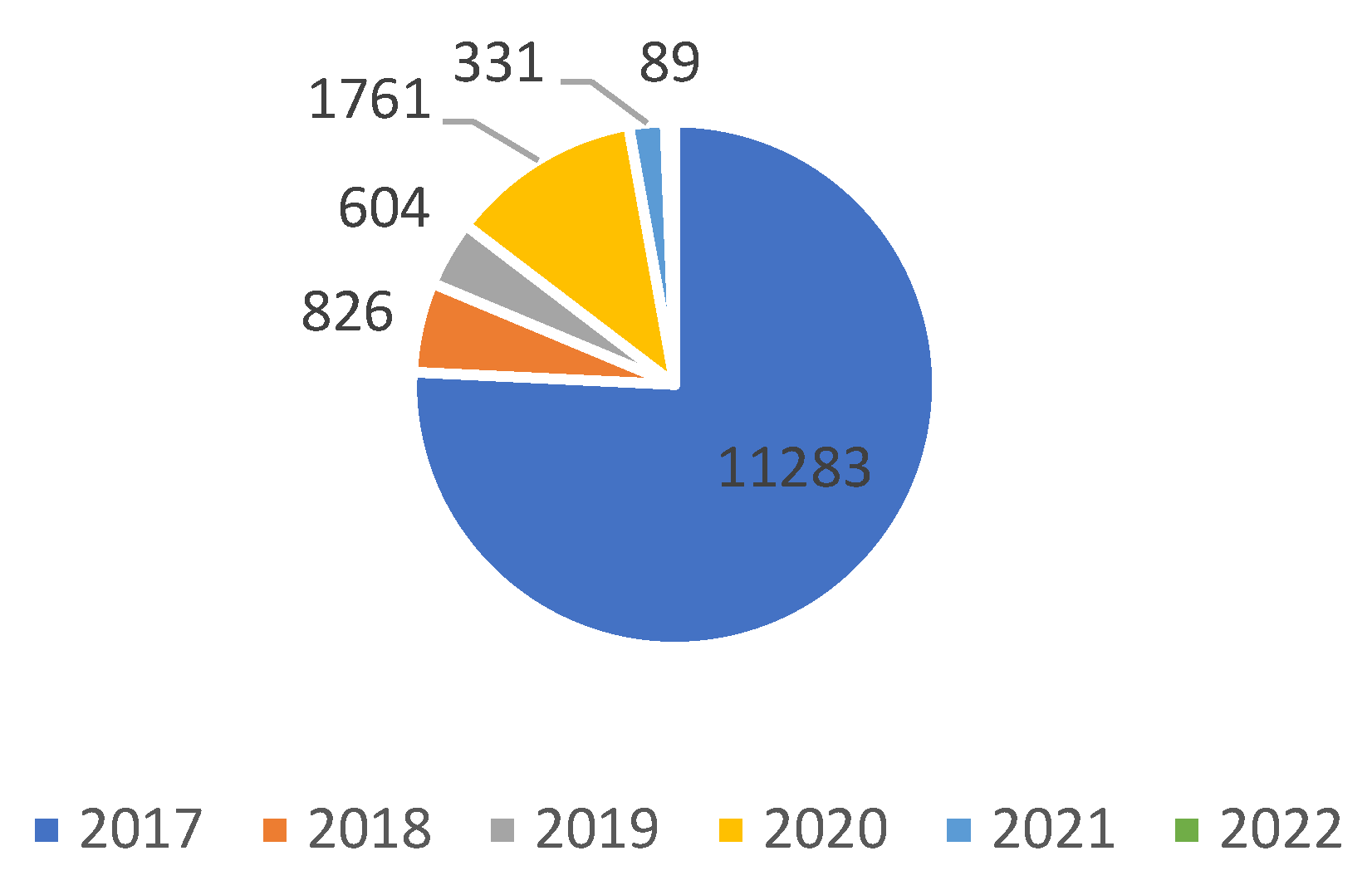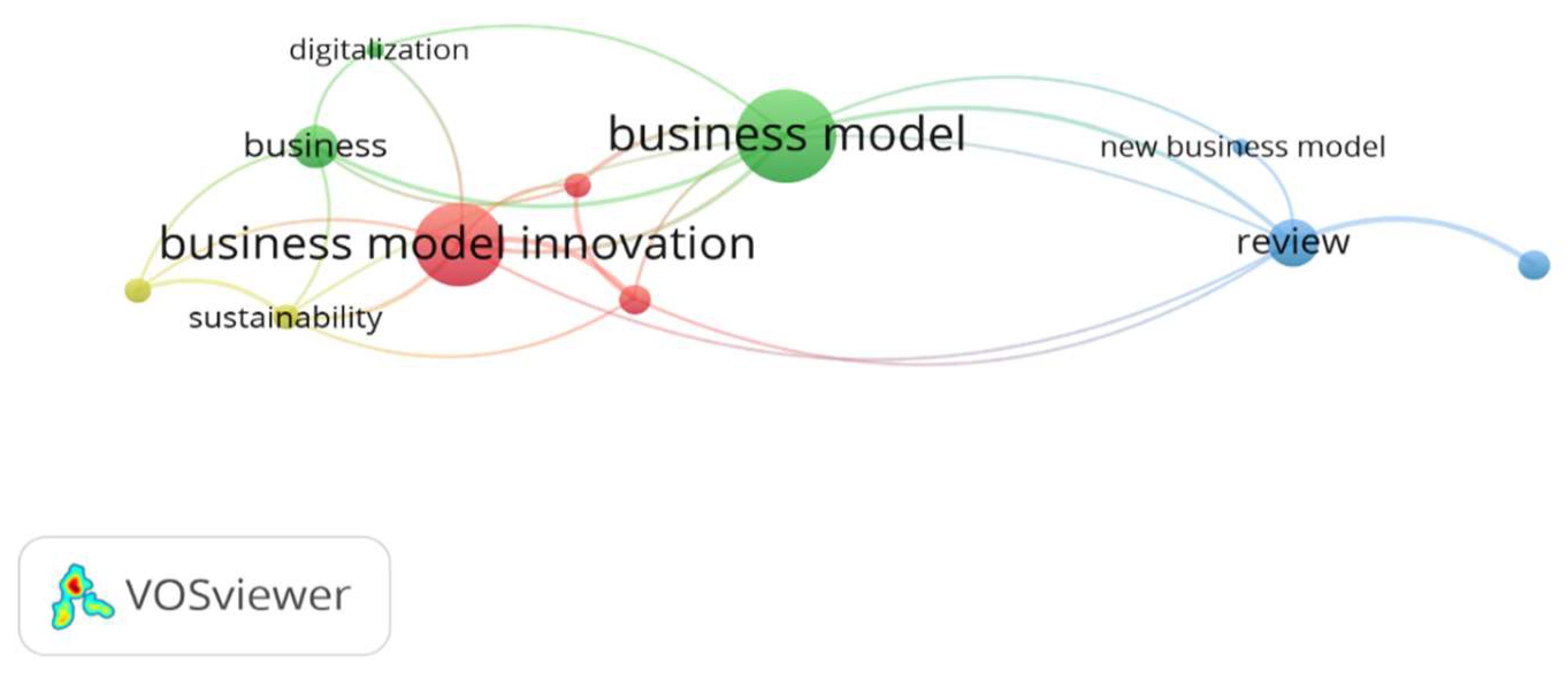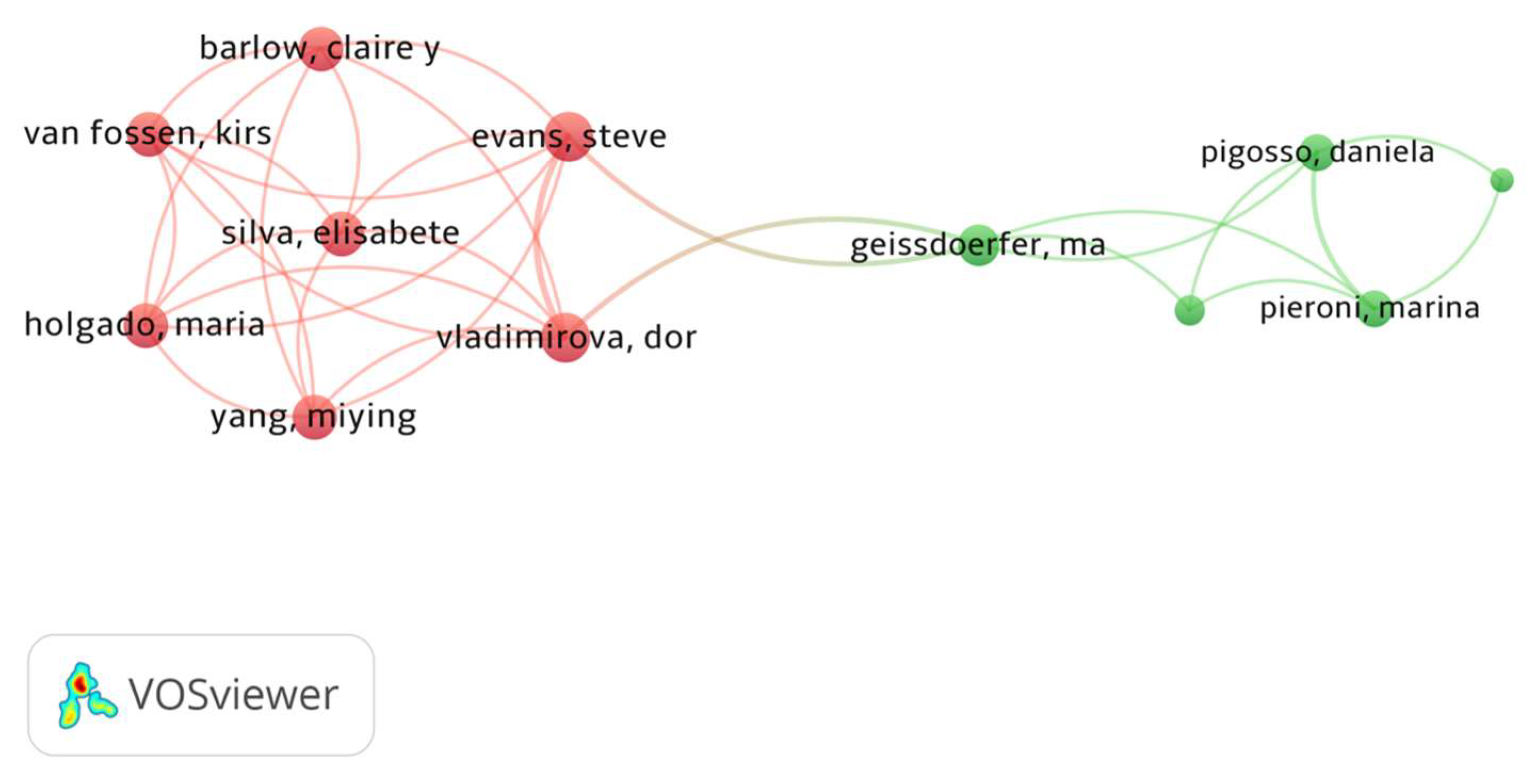State of the Art of Business Models: A Bibliometric Analysis
Abstract
:1. Introduction
2. Materials and Methods
3. Results
3.1. Publication by Years (2017–2022)
3.2. Publication by Journals (2017–2022)
3.3. Keyword Analysis (2017–2022)
3.4. Geographical Analysis of Publications (2017–2022)
3.5. Analysis of Publications by Organization (2017–2022)
3.6. Analysis of Publications by Citations (2017–2022)
| Article Title | Authors | Journals | Publication Year | Citations |
|---|---|---|---|---|
| Circular business models: A review | [30] | Journal of Cleaner Production | 2020 | 157 |
| Sustainable business model innovation: A review | [5] | Journal of Cleaner Production | 2018 | 120 |
| Characterizing Business Models for Digital Business Through Patterns | [31] | International Journal of Electronic Commerce | 2017 | 109 |
| Digitization capability and the digitalization of business models in business-to-business firms: Past, present, and future | [16] | Industrial Marketing Management | 2020 | 106 |
| Dynamic business modelling for sustainability: Exploring a system dynamics perspective to develop sustainable business models | [3] | Business Strategy and the Environment | 2019 | 100 |
| Anatomy of sustainable business model innovation | [22] | Journal of Cleaner Production | 2018 | 99 |
| Business Model Innovation for Sustainability: Towards a Unified Perspective for Creation of Sustainable Business Models | [32] | Business Strategy and the Environment | 2017 | 97 |
| Sustainable Business Model Innovation: An Umbrella Review | [5] | Sustainability | 2017 | 91 |
| Towards Sustainable Innovative Business Models | [33] | Sustainability | 2017 | 79 |
3.7. Bibliographic Coupling of Authors (2017–2022)
4. Discussion
5. Conclusions
5.1. Conclusions
5.2. Policy Recommendations
Author Contributions
Funding
Institutional Review Board Statement
Informed Consent Statement
Data Availability Statement
Conflicts of Interest
References
- Wirtz, B.W.; Pistoia, A.; Ullrich, S.; Göttel, V. Business models: Origin, development and future research perspectives. Long Range Plan. 2016, 49, 36–54. [Google Scholar] [CrossRef]
- Lanzolla, G.; Markides, C. A business model view of strategy. J. Manag. Stud. 2021, 58, 540–553. [Google Scholar] [CrossRef] [Green Version]
- Teece, D.J. Business models, business strategy and innovation. Long Range Plan. 2010, 43, 172–194. [Google Scholar] [CrossRef]
- Gassmann, O.; Frankenberger, K.; Sauer, R. Exploring the Field of Business Model Innovation: New Theoretical Perspectives; Springer: Berlin/Heidelberg, Germany, 2016. [Google Scholar]
- Geissdoerfer, M.; Morioka, S.N.; de Carvalho, M.M.; Evans, S. Business models and supply chains for the circular economy. J. Clean. Prod. 2018, 190, 712–721. [Google Scholar] [CrossRef]
- Foss, N.J.; Saebi, T. Fifteen years of research on business model innovation: How far have we come, and where should we go? J. Manag. 2017, 43, 200–227. [Google Scholar] [CrossRef] [Green Version]
- Casadesus-Masanell, R.; Zhu, F. Business model innovation and competitive imitation: The case of sponsor-based business models. Strateg. Manag. J. 2013, 34, 464–482. [Google Scholar] [CrossRef] [Green Version]
- Johnson, M.W.; Christensen, C.M.; Kagermann, H. Reinventing your business model. Harv. Bus. Rev. 2008, 86, 57–68. Available online: https://www.academia.edu/download/38668596/HBR_on_Strategy.pdf#page=57 (accessed on 14 March 2022).
- Chofreh, A.G.; Goni, F.A.; Zeinalnezhad, M.; Navidar, S.; Shayestehzadeh, H.; Klemeš, J.J. Value chain mapping of the water and sewage treatment to contribute to sustainability. J. Environ. Manag. 2019, 239, 38–47. [Google Scholar] [CrossRef]
- Guo, H.; Tang, J.; Su, Z.; Katz, J.A. Opportunity recognition and SME performance: The mediating effect of business model innovation. RD Manag. 2017, 47, 431–442. [Google Scholar] [CrossRef]
- Webster, K. The circular economy. In A Wealth of Flows; Ellen MacArthur Foundation Publishing: Cowes, UK, 2015; Volume 16. [Google Scholar]
- Rojek, T. Analysis of the pro-market concept of the business model. Mark. Manag. Innov. 2019, 2, 266–281. Available online: http://doi.org/10.21272/mmi.2019.2-23 (accessed on 28 March 2022). [CrossRef]
- Buckley, P.J.; Tian, X. Internalization theory and the performance of emerging-market multinational enterprises. Int. Bus. Rev. 2017, 26, 976–990. [Google Scholar] [CrossRef] [Green Version]
- Rockström, J.; Steffen, W.; Noone, K.; Persson, Å.; Chapin, F.S., III; Lambin, E.; Lenton, T.M.; Scheffer, M.; Folke, C.; Schellnhuber, H.J.; et al. Planetary boundaries: Exploring the safe operating space for humanity. Ecol. Soc. 2009, 14, 1–33. Available online: https://www.jstor.org/stable/26268316 (accessed on 28 March 2022). [CrossRef]
- Robert, K.W.; Parris, T.M.; Leiserowitz, A.A. What is sustainable development? Goals, indicators, values, and practice. Environ. Sci. Policy Sustain. Dev. 2005, 47, 8–21. Available online: https://www.tandfonline.com/doi/pdf/10.1080/00139157.2005.10524444 (accessed on 6 April 2022). [CrossRef]
- Evans, S.; Gregory, M.; Ryan, C.; Bergendahl, M.N.; Tan, A. Towards a Sustainable Industrial System: With Recommendations for Education, Research, Industry and Policy; University of Cambridge, Institute for Manufacturing: Cambridge, UK, 2009; Available online: http://www.ifm.eng.cam.ac.uk/sis/industrial_sustainability_report.pdf (accessed on 6 April 2022).
- Ekins, P. System innovation for environmental sustainability: Concepts, policies, and political economy. In International Economics of Resource Efficiency; Physica-Verlag HD: Berlin, Germany, 2011; pp. 51–88. [Google Scholar] [CrossRef]
- Bigelow, L.S.; Barney, J.B. What can strategy learn from the business model approach? J. Manag. Stud. 2021, 58, 528–539. [Google Scholar] [CrossRef]
- Dellyana, D.; Simatupang, T.M.; Dhewanto, W. Managing the actor’s network, Business Model Innovation to increase the value of the multidimensional value network. Int. J. Bus. Soc. 2018, 19, 209–218. Available online: http://www.ijbs.unimas.my/images/repository/pdf/Vol19-no1-paper14.pdf (accessed on 6 April 2022).
- Goni, F.A.; Gholamzadeh Chofreh, A.; Estaki Orakani, Z.; Klemeš, J.J.; Davoudi, M.; Mardani, A. Sustainable business model: A review and framework development. Clean Technol. Environ. Policy 2021, 23, 889–897. [Google Scholar] [CrossRef]
- Muñoz-Torres, M.J.; Fernández-Izquierdo, M.Á.; Rivera-Lirio, J.M.; Escrig-Olmedo, E. Can environmental, social, and governance rating agencies favor business models that promote more sustainable development? Corp. Soc. Responsib. Environ. Manag. 2019, 26, 439–452. [Google Scholar] [CrossRef]
- Shakeel, J.; Mardani, A.; Chofreh, A.G.; Goni, F.A.; Klemeš, J. Anatomy of sustainable business model innovation. J. Clean. Prod. 2020, 261, 121201. [Google Scholar] [CrossRef]
- Geissdoerfer, M.; Savaget, P.; Evans, S. The Cambridge business model innovation process. Procedia Manuf. 2017, 8, 262–269. [Google Scholar] [CrossRef]
- Geissdoerfer, M.; Bocken, N.M.; Hultink, E.J. Design thinking to enhance the sustainable business modeling process–A workshop based on a value mapping process. J. Clean. Prod. 2016, 135, 1218–1232. [Google Scholar] [CrossRef] [Green Version]
- Bagheri, S.K.; Raoufi, P.; Samandar Ali Eshtehardi, M.; Shaverdy, S.; Ramezani Akbarabad, B.; Moghaddam, B.; Mardani, A. Using the crowd for business model innovation: The case of Digikala. RD Manag. 2020, 50, 3–17. [Google Scholar] [CrossRef]
- Luthra, S.; Mangla, S.K. When strategies matter: Adoption of sustainable supply chain management practices in an emerging economy’s context. Resour. Conserv. Recycl. 2018, 138, 194–206. [Google Scholar] [CrossRef]
- Sjödin, D.; Parida, V.; Jovanovic, M.; Visnjic, I. Value creation and value capture alignment in business model innovation: A process view on outcome-based business models. J. Prod. Innov. Manag. 2020, 37, 158–183. [Google Scholar] [CrossRef] [Green Version]
- Jiménez-García, M.; Ruiz-Chico, J.; Peña-Sánchez, A.R.; López-Sánchez, J.A. A bibliometric analysis of sports tourism and sustainability (2002–2019). Sustainability 2020, 12, 2840. [Google Scholar] [CrossRef] [Green Version]
- Mulet-Forteza, C.; Martorell-Cunill, O.; Merigó, J.M.; Genovart-Balaguer, J.; Mauleon-Mendez, E. Twenty-five years of the Journal of Travel & Tourism Marketing: A bibliometric ranking. J. Travel Tour. Mark. 2018, 35, 1201–1221. [Google Scholar] [CrossRef]
- Geissdoerfer, M.; Pieroni, M.P.P.; Pigosso, D.C.A.; Soufani, K. Circular business models: A review. J. Clean. Prod. 2020, 227, 123741. [Google Scholar] [CrossRef]
- Beynon-Davies, P. Characterizing business models for digital business through patterns. Int. J. Electron. Commer. 2018, 22, 98–124. [Google Scholar] [CrossRef] [Green Version]
- Evans, S.; Vladimirova, D.; Holgado, M.; Van Fossen, K.; Yang, M.; Silva, E.A.; Barlow, C.Y. Business model innovation for sustainability: Towards a unified perspective for creation of sustainable business models. Bus. Strategy Environ. 2017, 26, 597–608. [Google Scholar] [CrossRef]
- López-Nicolás, C.; Ruiz-Nicolás, J.; Mateo-Ortuño, E. Towards Sustainable Innovative Business Models. Sustainability 2021, 13, 5804. [Google Scholar] [CrossRef]
- Prescott, J.E.; Filatotchev, I. The business model phenomenon: Towards theoretical relevance. J. Manag. Stud. 2021, 58, 517–527. [Google Scholar] [CrossRef]
- Jin, Y.; Ji, S.; Liu, L.; Wang, W. Business model innovation canvas: A visual business model innovation model. Eur. J. Innov. Manag. 2021, 25, 1469–1493. [Google Scholar] [CrossRef]
- Lamendola, R.; Genet, C. Single-or multi-sided business models: How does time perception influence business model choice? Int. J. Technol. Manag. 2022, 89, 46–67. Available online: https://www.inderscienceonline.com/doi/pdf/10.1504/IJTM.2022.123007 (accessed on 6 April 2022). [CrossRef]
- Bocken, N.; Boons, F.; Baldassarre, B. Sustainable business model experimentation by understanding ecologies of business models. J. Clean. Prod. 2019, 208, 1498–1512. [Google Scholar] [CrossRef]
- Athanasopoulou, A.; De Reuver, M. How do business model tools facilitate business model exploration? Evidence from action research. Electron. Mark. 2020, 30, 495–508. [Google Scholar] [CrossRef]
- Ganguly, A.; Euchner, J. Conducting Business Experiments: Validating New Business Models Well-designed business experiments can help validate assumptions and reduce risk associated with new business models. Res. Technol. Manag. 2018, 61, 27–36. [Google Scholar] [CrossRef]
- Dönmez-Turan, A.; Özevren, M. Designing a business model from process perspective. Afr. J. Sci. Technol. Innov. Dev. 2019, 11, 619–627. Available online: https://journals.co.za/doi/abs/10.1080/20421338.2018.1559994 (accessed on 6 April 2022). [CrossRef]
- Thomas, R.; Pedersen, C.L. Digitization capability and the digitalization of business models in business-to-business firms: Past, present, and future. Ind. Mark. Manag. 2020, 86, 180–190. [Google Scholar]
- Federico, C.; Rodrigues, V.P.; Rosati, F. Dynamic business modeling for sustainability: Exploring a system dynamics perspective to develop sustainable business models. Bus. Strategy Environ. 2020, 29, 651–664. [Google Scholar]



| Journals | Volume | % Out of 14881 |
|---|---|---|
| Business Process Management Workshops (BPM 2017) | 11,034 | 74.15% |
| Journal of Cleaner Production | 944 | 6.34% |
| Advances in Production Management Systems: Towards smart and Digital Manufacturing, PT II | 592 | 3.98% |
| Business Modelling and Software Design, 2020 | 391 | 2.63% |
| Business Modelling and Software Design, 2019 | 356 | 2.39% |
| Enterprise Information Systems, ICEIS 2016 | 291 | 1.96% |
| Wireless Personal Communications | 217 | 1.46% |
| Journal of Business Ethics | 152 | 1.02% |
| Journal of Business Research | 130 | 0.87% |
| International Journal of Technology Management | 89 | 0.60% |
| Industrial Marketing Management | 86 | 0.58% |
| Business Strategy and the Environment | 85 | 0.57% |
| Business Horizons | 63 | 0.42% |
| Research-Technology Management | 61 | 0.41% |
| Long Range Planning | 51 | 0.34% |
| Journal of Management Development | 36 | 0.24% |
| Proceeding of the second International Conference on Economic Business Management (FEBM 2017) | 33 | 0.22% |
| Technology Analysis & Strategic Management | 32 | 0.22% |
| Electronic Markets | 30 | 0.20% |
| NTU Management Review | 29 | 0.19% |
| Sustainability | 26 | 0.17% |
| Ekonomska Misao I Praksa-Economic Thought and Practice | 26 | 0.17% |
| International Journal of Electronic Commerce | 22 | 0.15% |
| International Journal of Innovation Management | 21 | 0.14% |
| International Journal of Business and Society | 19 | 0.13% |
| Innovation and Management Review | 15 | 0.10% |
| Journal of Competitiveness | 13 | 0.09% |
| IMP Journal | 11 | 0.07% |
| African Journal of Science Technology Innovation and Development | 11 | 0.07% |
| Journal of Family Business Management | 11 | 0.07% |
| 2017 IEEE 19th Conference on Business Informatics, Vol 1 | 2 | 0.01% |
| 2017 IEEE 19th Conference on Business Informatics, Vol 2 | 2 | 0.01% |
| Keywords | Occurrences | % Out of 64 |
|---|---|---|
| Business Model | 16 | 25% |
| Business Model Innovation | 14 | 22% |
| Review | 7 | 11% |
| Business | 6 | 9% |
| Sustainability Business Model | 4 | 6% |
| Approach | 4 | 6% |
| Sustainable Business Model | 3 | 5% |
| Sustainability | 3 | 5% |
| Pattern | 3 | 5% |
| New Business Model | 2 | 3% |
| Digitalization | 2 | 3% |
| Publications by City | Volume | % Out of 14881 |
|---|---|---|
| Cham | 12,065 | 81.08% |
| Oxford | 995 | 6.69% |
| Berlin | 599 | 4.03% |
| New York | 437 | 2.94% |
| Dordrecht | 152 | 1.02% |
| Geneva | 89 | 0.60% |
| Hoboken | 85 | 0.57% |
| Bingley | 73 | 0.49% |
| Abingdon | 65 | 0.44% |
| Amsterdam | 63 | 0.42% |
| Arlington | 61 | 0.41% |
| Paris | 33 | 0.22% |
| Heidelberg | 30 | 0.20% |
| Taiwan | 29 | 0.19% |
| Basel | 26 | 0.17% |
| Dubrovnik | 26 | 0.17% |
| Singapore | 21 | 0.14% |
| Sarawak | 19 | 0.13% |
| Zlin | 13 | 0.09% |
| Publisher (Organization) | Volume | % Out of 14,881 |
|---|---|---|
| International Publishing Ag | 12,065 | 81.08% |
| Elsevier Sci Ltd. | 1052 | 7.07% |
| Springer-Verlag Berlin | 599 | 4.03% |
| Springer | 369 | 2.48% |
| Elsevier Science Inc. | 130 | 0.87% |
| Inderscience Enterprises Ltd. | 89 | 0.60% |
| Elsevier Science Inc. | 86 | 0.58% |
| Wiley | 85 | 0.57% |
| Emerald Group Publishing Ltd. | 73 | 0.49% |
| Routledge Journals, Taylor, & Francis Ltd. | 65 | 0.44% |
| Elsevier | 63 | 0.42% |
| Industrial Research Inst, Inc. | 61 | 0.41% |
| Atlantis Press | 33 | 0.22% |
| Springer Heidelberg | 30 | 0.20% |
| Natl Taiwan Univ, Coll Management | 29 | 0.19% |
| MDPI | 26 | 0.17% |
| Univ Dubrovnik | 26 | 0.17% |
| World Scientific Publ. Co. PTE Ltd. | 21 | 0.14% |
| Univ Malaysia Sarawak, Fac Economics & Business | 19 | 0.13% |
| Univ Tomase Bati & Zline, Fak Management Tu Ekonomiky | 13 | 0.09% |
| MDPI | 13 | 0.09% |
| IEEE | 4 | 0.03% |
Disclaimer/Publisher’s Note: The statements, opinions and data contained in all publications are solely those of the individual author(s) and contributor(s) and not of MDPI and/or the editor(s). MDPI and/or the editor(s) disclaim responsibility for any injury to people or property resulting from any ideas, methods, instructions or products referred to in the content. |
© 2023 by the authors. Licensee MDPI, Basel, Switzerland. This article is an open access article distributed under the terms and conditions of the Creative Commons Attribution (CC BY) license (https://creativecommons.org/licenses/by/4.0/).
Share and Cite
Carmo, R.d.; Jerónimo, C.; Pereira, L.; Dias, Á.; Patricio, V. State of the Art of Business Models: A Bibliometric Analysis. Sustainability 2023, 15, 4482. https://doi.org/10.3390/su15054482
Carmo Rd, Jerónimo C, Pereira L, Dias Á, Patricio V. State of the Art of Business Models: A Bibliometric Analysis. Sustainability. 2023; 15(5):4482. https://doi.org/10.3390/su15054482
Chicago/Turabian StyleCarmo, Rodrigo do, Carlos Jerónimo, Leandro Pereira, Álvaro Dias, and Vânia Patricio. 2023. "State of the Art of Business Models: A Bibliometric Analysis" Sustainability 15, no. 5: 4482. https://doi.org/10.3390/su15054482
APA StyleCarmo, R. d., Jerónimo, C., Pereira, L., Dias, Á., & Patricio, V. (2023). State of the Art of Business Models: A Bibliometric Analysis. Sustainability, 15(5), 4482. https://doi.org/10.3390/su15054482








